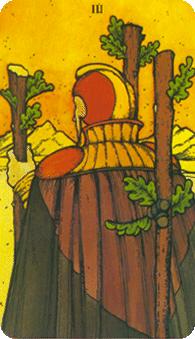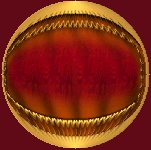Tarot & Christianity: 3 of Wands
St. John in Exile on Patmos Island
(c) Cheryl Lynne Bradley 2005-10

The traditional imagery of the 3 of Wands in Tarot depicts a man standing on a seashore staring across the ocean into the distance. He is deep in thought and we wonder what, or who, he is waiting for there on the edge of that island. Is he waiting for a ship to bring him worldly treasures, or news and passage that will return him to his home? We wonder how often he has come to this place to wait and reflect on his circumstances. Has he just sent news forth and is wondering about the impact of his messages or even if they will get through? Perhaps he is waiting for word on when he can return home. It reminds me of the exile of St. John to the Island of Patmos, the place where it is said he had his vision and wrote the Book of Revelation. His home was a grotto on the island. This grotto is now called Apokalypsis or the Cave of Revelation. It was through a crack in the ceiling of his grotto where Jesus appeared to the exiled apostle.
John dictated the details of his extraordinary vision to his disciple Prochorus. John was instructed that this Revelation of the victory of church was to be documented as something that could be seen; it was to be written down. It was also given as something that was to be sent; it was to be distributed to the seven established Christian churches at Ephesus, Smyrna, Pergamos, Thyatira, Sardis, Philadelphia, and Laodicea. This is why the island of Patmos became the centre for Orthodox Christianity. The Cave of Revelation lies between Chora (Hora) and Skala.
According to Roman mythology the island of Patmos was a gift from Jupiter (Zeus) to his daughter, Diana (Artemis), the goddess of the hunt and young women, and she was worshipped there. The Greek mythological hero Orestes, who was the brother of Electra and the son of Agammemnon of Trojan War fame, sought refuge on Patmos Island from the pursuit of the Erinnyes over the murder of his mother, Clymtemnestra. Over the years the island paid tribute to Athens (5th century BC), the Macedonians (4th century BC), with the Romans taking it over in the 2nd century BC.
John was one of the Boanerges, he and his brother James were the sons of Zebedee and Salome. The family were Palestinian Jews. Jesus called John and James the Sons of Thunder for their fiery speaking style, passionate discourses and their deep gutteral Galilean accent. John was an early disciple of John the Baptist. John is thought to be the younger of the two brothers and he was the second most prominent apostle after Peter. Jesus entrusted the care of his mother to John from the cross on Calvary and John was the first apostle to learn of Judas' betrayal.
John was the only apostle who witnessed the crucifixion of Jesus and he is thought to be the beloved apostle, 'the disciple whom Jesus loved'. John 13:23; 19:26; 21:20, 24, and the author of the fourth gospel, the Gospel of John, also called the Book of Love. He wrote three other letters under his name besides the Gospel of John and the Book of Revelation. Some scholars believe it is possible that Mary Magdelene was the beloved apostle and possibly authored the fourth gospel, but that is a discussion for another article. John was a married man and a fisherman with his brother by profession until he answered Jesus' call. His wife supported the ministry of Jesus and the apostles with her wealth.
In 95 AD St. John was banished from Miletus by Emperor Domitian to the island of Patmos for preaching the Gospel at Ephesus. The Romans regularly used Patmos Island as a place of exile. Patmos Island is narrow and rocky, located on the eastern border of the Aegean Sea, between Leros and Ikaria. It is an island about 10 miles long and 6 miles wide often called the Jerusalem of the Aegean. The Island of Patmos is today part of Greece. It is located among the Sporades group of islands, near the west coast of Turkey and is known for having very strong winds. It has a very irregular coastline and is one of the smallest islands in this group.
The Romans housed political prisoners and criminals on the island. Political prisoners had freedom to wander the island and were not forced to do the same hard labour in the mines and quarries as the criminals did. Christians, at that time, were deemed to be criminals and were fettered as well as lacking adequate food and clothing. They slept on the bare ground in caves. John was an old man of 90 when he was exiled to this place, it must have been a trememdous hardship for him. Some think he was plunged into a pot of boiling oil before he was exiled.
The Book of Revelation is one of the most widely debated, and certainly the most controversial, books of the New Testament. In the 4th century, high ranking bishops argued heavily about using the book in the canon of the New Testament. The chief concern were the difficulty in interpreting the text and the danger of abuse and misuse. It is included in the canon of the Eastern Orthodox Church but it is the only book that is not read within their Divine Liturgy.
In the 17th century, a monastery was built around the cave in which St. John wrote the Book of Revelation. The port at Patmos Island is called Skala and on the top of the cliffs stands Chora (Hora), the capital. The middle of the island has been dominated by the massive Byzantine monastery of St John Theologos. It was built in 1088 under the order of Emperor Alexios Komninos and founded by Ioannis Christodoulos, a leading member of the Eastern Orthodox church at the time.
These days the most common way to get to Patmos is to fly to Athens and then take the boat from there to the port of Pieraus. Patmos is also connected with the rest of the Dodecannese, and is close to the islands of Mykonos, Samos and Tenos. Chora was built like a labryinth in order to discourage pirates and there are lots of local crafts available as well as many beaches - most of the beaches are stone but there is one sand beach.
Other places of interest on the island are the nunnery of Zoodochos Pigis (Life-giving Source) which is in Chora and can be visited at certain times. The most active nunnery is outside the village and is called Evangelismos. There is another monastery called Profitis Elias (Prophet Elias). It is the highest point of the island (269m) so you would have to be into a climb. In order to visit any of these places, proper dress is required. Women must wear long skirts and have their shoulders covered. Men must wear long pants.
John's exile ended in 97AD and he returned to Ephesus. John is the only Apostle believed to have lived to an old age and to die a natural death. There is no record of him being martyred. Some think he died on the island of Patmos (Revelation 1:9) although some sources believe he died at Ephesus.

















